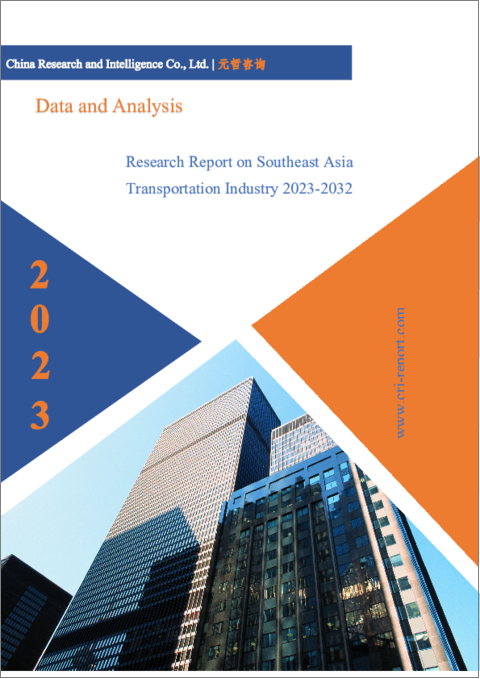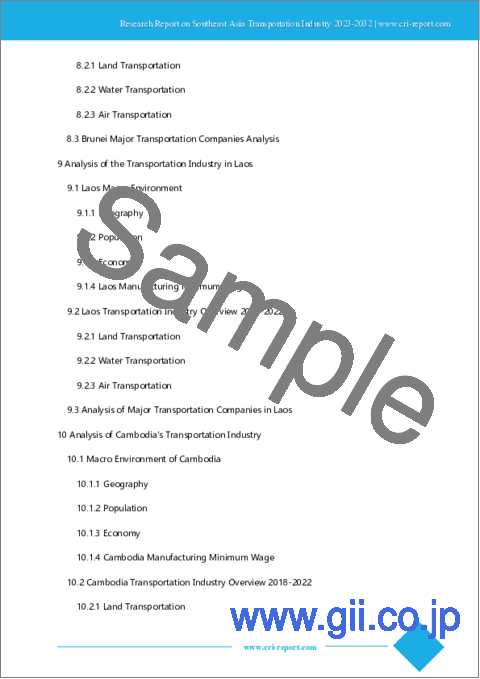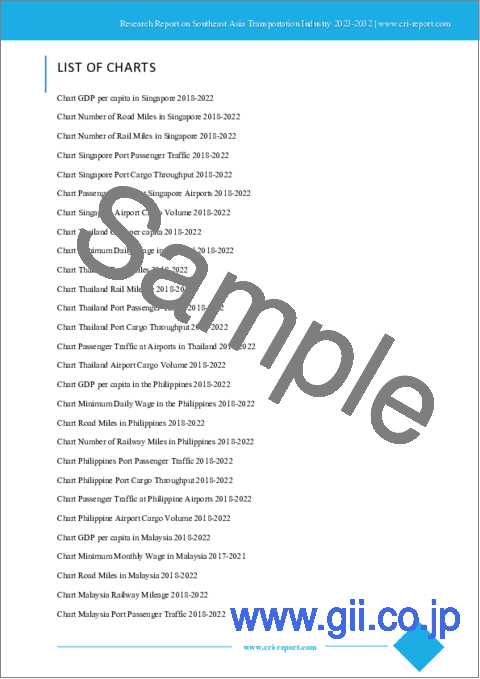|
|
市場調査レポート
商品コード
1171674
東南アジアの運輸業界:2023年~2032年Research Report on Southeast Asia Transportation Industry 2023-2032 |
||||||
| 東南アジアの運輸業界:2023年~2032年 |
|
出版日: 2022年12月13日
発行: China Research and Intelligence
ページ情報: 英文 80 Pages
納期: 即日から翌営業日
|
- 全表示
- 概要
- 目次
東南アジア諸国における運輸業界の発展にはかなりの差があります。東南アジア諸国の中で最も道路走行距離が長いのはタイで、2020年の総道路走行距離は約70万km、次いでベトナム、インドネシアが約60万kmです。鉄道では、インドネシアとミャンマーが2020年の総鉄道走行距離で6,000kmを超え、東南アジア諸国の中で最も鉄道走行距離が長い国となっています。2022年時点で、ラオスの鉄道総走行距離は400kmを超えます。
当レポートでは、東南アジアの運輸業界について調査し、国別の市場動向、今後の展望などをまとめています。
目次
第1章 シンガポールの運輸業界の分析
- シンガポールのマクロ環境
- シンガポールの運輸業界の概要:2018年~2022年
- 陸上輸送
- 水上輸送
- 航空輸送
- シンガポールの主要な運輸会社の分析
第2章 タイの運輸業界の分析
- タイのマクロ環境
- タイの運輸業界の概要:2018年~2022年
- 陸上輸送
- 水上輸送
- 航空輸送
- タイの主要な運輸会社の分析
第3章 フィリピンの運輸業界の分析
- フィリピンのマクロ環境
- フィリピンの運輸業界の概要:2018年~2022年
- 陸上輸送
- 水上輸送
- 航空輸送
- フィリピンの主要な運輸会社の分析
第4章 マレーシアの運輸業界の分析
- マレーシアのマクロ環境
- マレーシアの運輸業界の概要:2018年~2022年
- 陸上輸送
- 水上輸送
- 航空輸送
- マレーシアの主要な運輸会社の分析
第5章 インドネシアの運輸業界の分析
- インドネシアのマクロ環境
- インドネシアの運輸業界の概要:2018年~2022年
- 陸上輸送
- 水上輸送
- 航空輸送
- インドネシアの主要な運輸会社の分析
第6章 ベトナムの運輸業界の分析
- ベトナムのマクロ環境
- ベトナムの運輸業界の概要:2018年~2022年
- 陸上輸送
- 水上輸送
- 航空輸送
- ベトナムの主要な運輸会社の分析
第7章 ミャンマーの運輸業界の分析
- ミャンマーのマクロ環境
- ミャンマーの運輸業界の概要:2018年~2022年
- 陸上輸送
- 水上輸送
- 航空輸送
- ミャンマーの主要な運輸会社の分析
第8章 ブルネイの運輸業界の分析
- ブルネイのマクロ環境
- ブルネイの運輸業界の概要:2018年~2022年
- 陸上輸送
- 水上輸送
- 航空輸送
- ブルネイの主要な運輸会社の分析
第9章 ラオスの運輸業界の分析
- ラオスのマクロ環境
- ラオスの運輸業界の概要:2018年~2022年
- 陸上輸送
- 水上輸送
- 航空輸送
- ラオスの主要な運輸会社の分析
第10章 カンボジアの運輸業界の分析
- カンボジアのマクロ環境
- カンボジアの運輸業界の概要:2018年~2022年
- 陸上輸送
- 水上輸送
- 航空輸送
- カンボジアの主要な運輸会社の分析
第11章 東南アジアの運輸業界の今後の見通し:2023年~2032年
- 東南アジアの運輸業界の発展に影響を与える要因の分析
- 東南アジアの運輸業界の供給予測:2023年~2032年
- 東南アジアの運輸業界の需要予測:2023年~2032年
- COVID-19アウトブレイクが運輸業界に及ぼす影響
Southeast Asia in this report includes 10 countries: Singapore, Thailand, Philippines, Malaysia, Indonesia, Vietnam, Myanmar, Brunei, Laos and Cambodia. With a total population of over 600 million by the end of 2021, Southeast Asia has an overall economic growth rate higher than the global average and is one of the key drivers of future global economic growth.
According to CRI's analysis, the economic levels of the 10 Southeast Asian countries vary greatly, with Singapore being the only developed country with a per capita GDP of about US$73,000 in 2021. While Myanmar and Cambodia will have a GDP per capita of less than US$2,000 in 2021. The population and minimum wage levels also vary greatly from country to country, with Brunei, which has the smallest population, having a total population of less than 500,000 people in 2021, and Indonesia, which has the largest population, having a population of about 275 million people in 2021. The most economically advanced countries in Southeast Asia do not have a legal minimum wage, with the actual minimum wage exceeding US$400 per month (for foreign maids), while the lowest minimum wage level in Myanmar is only about US$93 per month.
The development of the transport sector in Southeast Asian countries varies considerably. Thailand has the largest road mileage among Southeast Asian countries, with a total road mileage of about 700,000 km in 2020, followed by Vietnam and Indonesia with about 600,000 km. In terms of railroads, Indonesia and Myanmar have the largest rail mileage among Southeast Asian countries with a total rail mileage of over 6,000 km in 2020. As of 2022, Laos has a total rail mileage of over 400 km.
Singapore is the most developed country in Southeast Asia in terms of water transport. In 2020, the port of Singapore will have a foreign trade cargo throughput of 590 million tons and a container throughput of 36,871,000 TEUs, while Myanmar will have a container throughput of only about 1 million TEUs.
With more than two hundred airports serving domestic routes, Indonesia ranks among the top Southeast Asian countries in terms of domestic passenger and cargo traffic. Among international routes, Thailand ranked first among Southeast Asian countries with over 80 million international passengers in 2019, while Brunei and Laos had only about 2 million international passengers. In terms of cargo, Singapore Airport had the highest international cargo throughput, with 930,000 tons of international cargo loaded and 1,084,000 tons unloaded in 2019, 50 times the international cargo throughput of Brunei and Laos in the same period.
Overall, the transportation industry in Southeast Asian countries has been developing in recent years, especially the rise of emerging markets such as Vietnam and Thailand, with rapid economic growth, which has driven the development of the transportation industry.
According to CRI forecast, Southeast Asia's transportation industry will continue to grow from 2023-2032. On the one hand, cheap labor and land costs have attracted a large number of foreign investors to shift their production capacity to Southeast Asia, and the scale of foreign trade has expanded, promoting the development of its transportation industry. On the other hand, Southeast Asia's economic growth and increased domestic passenger and freight demand will also promote the development of the transportation industry.
Topics covered:
- Southeast Asia Transportation Industry Status and Major Sources in 2018-2022
- What is the Impact of COVID-19 on Southeast Asia Transportation Industry?
- Which Companies are the Major Players in Southeast Asia Transportation Industry Market and What are their Competitive Benchmarks?
- Key Drivers and Market Opportunities in Southeast Asia Transportation Industry
- What are the Key Drivers, Challenges, and Opportunities for Southeast Asia Transportation Industry during 2023-2032?
- What is the Expected Revenue of Southeast Asia Transportation Industry during 2023-2032?
- What are the Strategies Adopted by the Key Players in the Market to Increase Their Market Share in the Industry?
- What are the Competitive Advantages of the Major Players in Southeast Asia Transportation Industry Market?
- Which Segment of Southeast Asia Transportation Industry is Expected to Dominate the Market in 2032?
- What are the Major Adverse Factors Facing Southeast Asia Transportation Industry?
Table of Contents
1 Analysis of Singapore's Transportation Industry
- 1.1 Singapore Macro Environment
- 1.1.1 Geography
- 1.1.2 Population
- 1.1.3 Economy
- 1.1.4 Singapore Manufacturing Minimum Wage
- 1.2 Singapore Transportation Industry Overview 2018-2022
- 1.2.1 Land Transportation
- 1.2.2 Water Transportation
- 1.2.3 Air Transportation
- 1.3 Analysis of Major Transportation Companies in Singapore
2 Analysis of Thailand's Transportation Industry
- 2.1 Thailand Macro Environment
- 2.1.1 Geography
- 2.1.2 Population
- 2.1.3 Economy
- 2.1.4 Thailand Manufacturing Minimum Wage
- 2.2 Thailand Transportation Industry Overview 2018-2022
- 2.2.1 Land Transportation
- 2.2.2 Water Transportation
- 2.2.3 Air Transportation
- 2.3 Analysis of Major Transportation Companies in the Philippines
3 Analysis of the Transportation Industry in the Philippines
- 3.1 Macro Environment of the Philippines
- 3.1.1 Geography
- 3.1.2 Population
- 3.1.3 Economy
- 3.1.4 Philippines Manufacturing Minimum Wage
- 3.2 Philippine Transportation Industry Overview 2018-2022
- 3.2.1 Land Transportation
- 3.2.2 Water Transportation
- 3.2.3 Air Transportation
- 3.3 Analysis of Major Transportation Companies in the Philippines
4 Analysis of Malaysia's Transportation Industry
- 4.1 Malaysia Macro Environment
- 4.1.1 Geography
- 4.1.2 Population
- 4.1.3 Economy
- 4.1.4 Malaysia Manufacturing Minimum Wage
- 4.2 Malaysia Transportation Industry Overview 2018-2022
- 4.2.1 Land Transportation
- 4.2.2 Water Transportation
- 4.2.3 Air Transportation
- 4.3 Analysis of Major Transportation Companies in Malaysia
5 Indonesia Transportation Industry Analysis
- 5.1 Indonesia Macro Environment
- 5.1.1 Geography
- 5.1.2 Population
- 5.1.3 Economy
- 5.1.4 Indonesia Manufacturing Minimum Wage
- 5.2 Indonesia Transportation Industry Overview 2018-2022
- 5.2.1 Land Transportation
- 5.2.2 Water Transportation
- 5.2.3 Air Transportation
- 5.3 Analysis of Major Transportation Companies in Indonesia
6 Analysis of Vietnam's Transportation Industry
- 6.1 Vietnam Macro Environment
- 6.1.1 Geography
- 6.1.2 Population
- 6.1.3 Economy
- 6.1.4 Vietnam Manufacturing Minimum Wage
- 6.2 Vietnam Transportation Industry Overview 2018-2022
- 6.2.1 Land Transportation
- 6.2.2 Water Transportation
- 6.2.3 Air Transportation
- 6.3 Analysis of Major Transportation Companies in Vietnam
7 Analysis of Myanmar's Transportation Industry
- 7.1 Myanmar Macro Environment
- 7.1.1 Geography
- 7.1.2 Population
- 7.1.3 Economy
- 7.1.4 Myanmar Manufacturing Minimum Wage
- 7.2 Myanmar Transportation Industry Overview 2018-2022
- 7.2.1 Land Transportation
- 7.2.2 Water Transportation
- 7.2.3 Air Transportation
- 7.3 Analysis of Major Transportation Companies in Myanmar
8 Analysis of Brunei's Transportation Industry
- 8.1 Brunei Macro Environment
- 8.1.1 Geography
- 8.1.2 Population
- 8.1.3 Economy
- 8.1.4 Brunei Manufacturing Minimum Wage
- 8.2 Brunei Transportation Industry Overview 2018-2022
- 8.2.1 Land Transportation
- 8.2.2 Water Transportation
- 8.2.3 Air Transportation
- 8.3 Brunei Major Transportation Companies Analysis
9 Analysis of the Transportation Industry in Laos
- 9.1 Laos Macro Environment
- 9.1.1 Geography
- 9.1.2 Population
- 9.1.3 Economy
- 9.1.4 Laos Manufacturing Minimum Wage
- 9.2 Laos Transportation Industry Overview 2018-2022
- 9.2.1 Land Transportation
- 9.2.2 Water Transportation
- 9.2.3 Air Transportation
- 9.3 Analysis of Major Transportation Companies in Laos
10 Analysis of Cambodia's Transportation Industry
- 10.1 Macro Environment of Cambodia
- 10.1.1 Geography
- 10.1.2 Population
- 10.1.3 Economy
- 10.1.4 Cambodia Manufacturing Minimum Wage
- 10.2 Cambodia Transportation Industry Overview 2018-2022
- 10.2.1 Land Transportation
- 10.2.2 Water Transportation
- 10.2.3 Air Transportation
- 10.3 Analysis of Major Transportation Companies in Cambodia
11 Southeast Asia Transportation Industry Outlook 2023-2032
- 11.1 Analysis of Factors Affecting the Development of Southeast Asia's Transportation Industry
- 11.1.1 Favorable Factors
- 11.1.2 Unfavorable Factors
- 11.2 Southeast Asia Transportation Industry Development Forecast 2023-2032
- 11.3 Impact of the COVID-19 Outbreak on the Transportation Industry




